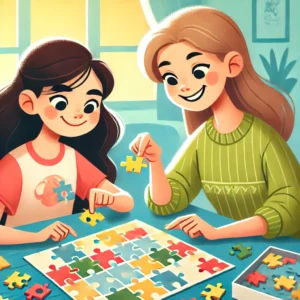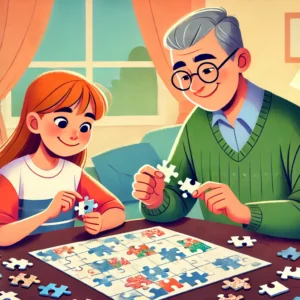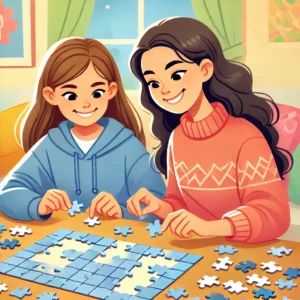
Did you know there is such a thing as jigsaw puzzle etiquette?
Jigsaw puzzles may seem like a simple and relaxing activity, but true puzzlers know there’s an unwritten code of conduct when solving puzzles – especially in group settings. Whether you’re working on a puzzle solo, with family, or in a public space, certain habits can enhance or disrupt the experience for everyone involved.
The Hidden Etiquette of Puzzling
From mixing pieces from different puzzles to forcing pieces into the wrong spots, certain puzzle-solving mistakes can cause frustration. These jigsaw puzzle etiquette rules help ensure that everyone has a fair and enjoyable experience.
Table of Contents
If you’ve ever wondered what proper puzzle-solving rules look like, here are 10 essential jigsaw puzzle etiquette rules every puzzler should follow. Most are fairly obvious, but then again, when it comes to group settings, jigsaw puzzle etiquette rules sometimes are assumed and not spoken.
Rule #1: Never Mix Pieces from Different Puzzles
One of the biggest jigsaw puzzle etiquette mistakes is accidentally (or intentionally) mixing pieces from two different puzzles. Not only does this make solving much harder, but it also increases the chance of losing or misplacing pieces permanently.
Some puzzle pieces may look similar but belong to completely different sets, making it impossible to complete either puzzle. This is especially frustrating when working on a large puzzle, as finding an out-of-place piece can waste time and cause confusion.
- Always keep puzzle boxes separate when working on multiple puzzles.
- If sorting pieces into trays, label them clearly to avoid mix-ups.
- Before cleaning up, double-check that all pieces belong to the right puzzle.
Rule #2: Don’t Take a Piece Just to Be Last
There’s something satisfying about placing the final puzzle piece, but claiming it just to say you “finished the puzzle” can take away the accomplishment from others — especially in a group setting.
Puzzles are meant to be collaborative, and every piece placed is part of the shared experience. The last piece is no more important than the rest and grabbing it just to be first goes against the spirit of teamwork.
If solving in a group, let whoever has done the most work place the last piece.
Focus on teamwork rather than competition – puzzles should be collaborative, not competitive.

Rule #3: Always Sort Pieces First
Jumping straight into placing pieces randomly may seem like a good idea, but experienced puzzlers know that sorting is key to a smoother and more enjoyable solving process.
Sorting pieces by color, pattern, or edge type helps establish a structured approach to solving the puzzle. It also prevents frustration caused by searching through a scattered pile of unorganized pieces.
- Separate edge pieces from interior pieces to form the puzzle’s border first.
- Sort by color groups or distinctive patterns to quickly identify sections.
- Keeping pieces organized makes the entire puzzle-solving experience more efficient.
Rule #4: Respect the Puzzle Space
A designated puzzle area should be kept tidy and respected to avoid losing pieces or disrupting progress. Since many puzzles take multiple days or weeks to complete, maintaining a clean and organized workspace is crucial.
Some puzzles are complex and require deep focus, so unnecessary distractions – like loud music or moving pieces around without permission – can be disruptive. Respecting the puzzle space ensures everyone enjoys the process without frustration. Puzzle Etiquette rules like this one is all about common sense.
- Avoid eating or drinking near the puzzle – spills can ruin pieces permanently.
- If working in a shared space, ask before moving or adjusting the puzzle.
- Use a puzzle mat or board for easy storage if the puzzle needs to be moved.
Rule #5: Don’t Hoard Pieces
Some puzzlers grab a handful of pieces and keep them to themselves, thinking they’ll solve sections faster. However, this can slow down progress for the rest of the group and frustrate fellow puzzlers.
Jigsaw puzzles work best when everyone has access to all the pieces. Keeping pieces to yourself limits teamwork and can make others feel excluded. Etiquette offers a fair and balanced playing field.
- Keep puzzle pieces visible and accessible to all players.
- If you find a piece that belongs in another section, hand it over rather than keeping it to yourself.
Rule #6: Work on One Section at a Time

Jumping around the puzzle without a plan can make solving disorganized and overwhelming. Instead, focusing on one section at a time allows for quicker completion and a more enjoyable experience.
Certain sections, such as faces, bold patterns, or text, are easier to complete first. Establishing these areas helps to create structure and guide the rest of the puzzle-solving process.
- Start with edges, then move to distinct color areas or detailed sections.
- Avoid spreading puzzle pieces too far apart, making it harder to see connections.
Rule #7: Don’t Force Pieces That Don’t Fit
One of the most common puzzle-solving mistakes is trying to force a piece into a spot where it doesn’t belong. While some pieces may appear to fit, they might actually be from a different section – or worse, the wrong puzzle entirely.
A piece should click into place naturally. If you have to push too hard, it’s probably not meant to be there.
- Always check both the shape and the image before placing a piece.
- If a piece doesn’t fit, try rotating it or setting it aside for later.
Rule #8: Keep Track of Missing Pieces
Few things are worse than realizing a piece is missing when you’re close to finishing the puzzle. Keeping track of all pieces prevents frustration and ensures a complete puzzle experience.
- If a piece is missing, check under the table, chairs, or puzzle box before assuming it’s lost.
- Keep small children and pets away from puzzle pieces – they often “borrow” pieces unknowingly.
Rule #9: Handle Puzzle Pieces with Care
Jigsaw puzzles are meant to be enjoyed multiple times, so handling the pieces properly extends their lifespan. Pieces that are bent, ripped, or smudged can ruin the puzzle for future use.
- Hold pieces by the edges to avoid damage.
- Store unfinished puzzles in a safe place away from direct sunlight or moisture.
Rule #10: Have Fun and Be Patient
Jigsaw puzzles are meant to be relaxing, engaging, and rewarding. Instead of rushing, focus on enjoying the process and appreciating the challenge.
- If you feel frustrated, take a break and come back with fresh eyes.
- Remember, puzzling is about the journey, not just the final image.
Jigsaw puzzles are more than just a pastime – they’re a shared experience that brings people together. Whether solving solo or with a group, following proper puzzle etiquette ensures that everyone enjoys the process without frustration. By respecting the puzzle space, working collaboratively, and handling pieces with care, you can create a more enjoyable and rewarding puzzling experience for yourself and others.
Relax! Jigsaw Puzzle Etiquette Rules Can Be Broken
The next time you sit down to complete a puzzle, keep these puzzle etiquette unwritten rules in mind. Not only will they help you solve puzzles more efficiently, but they’ll also foster a respectful and cooperative environment for fellow puzzlers. After all, the best part of puzzling isn’t just finishing the image it’s the journey of solving it, one piece at a time.
